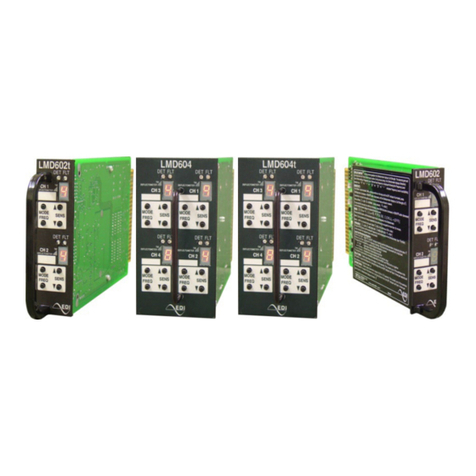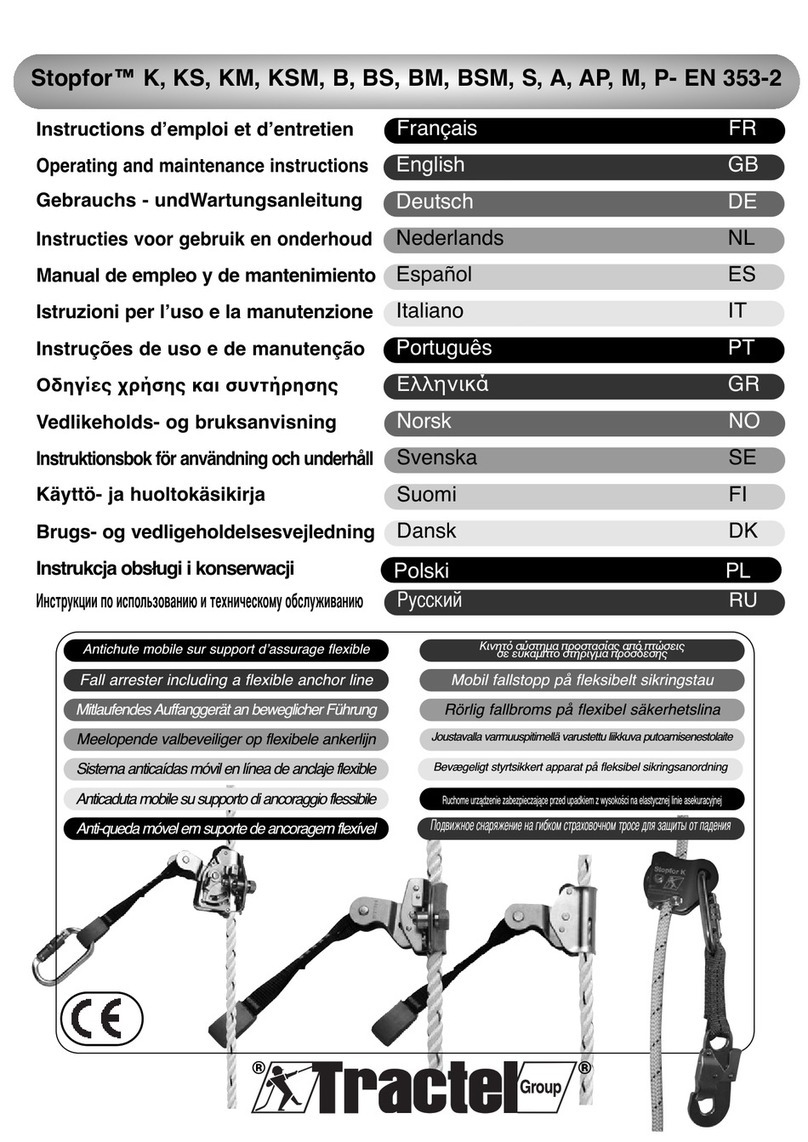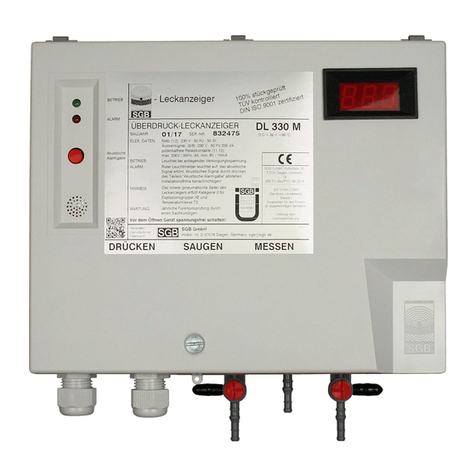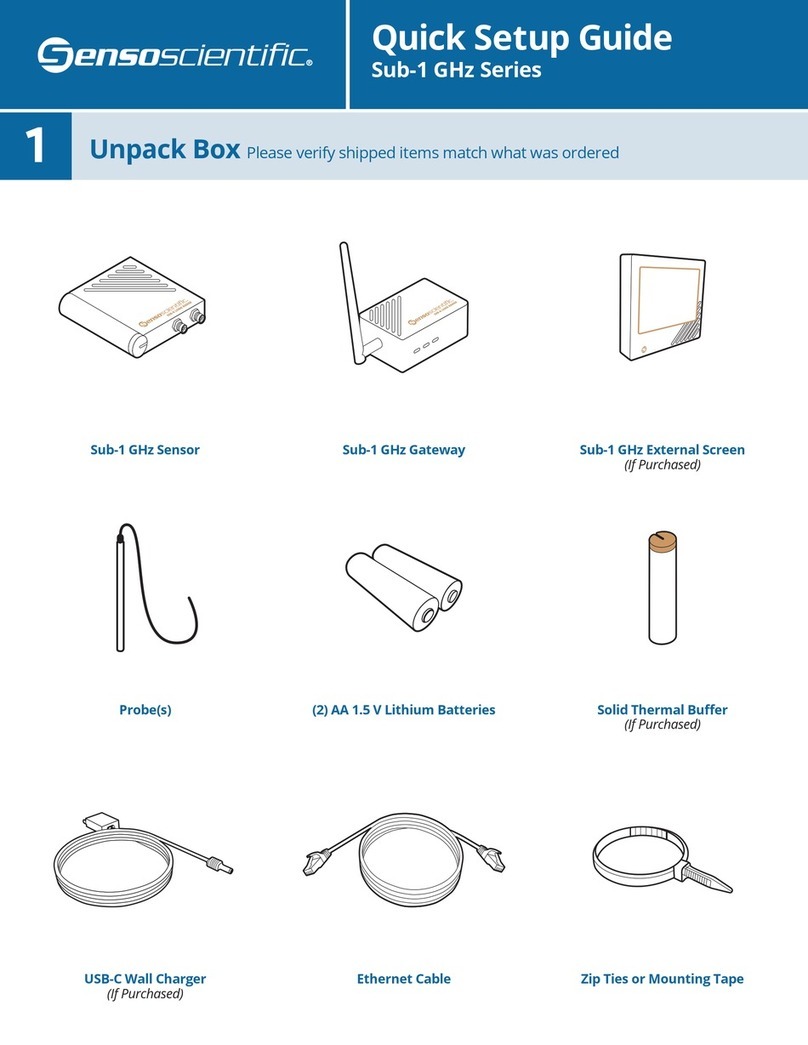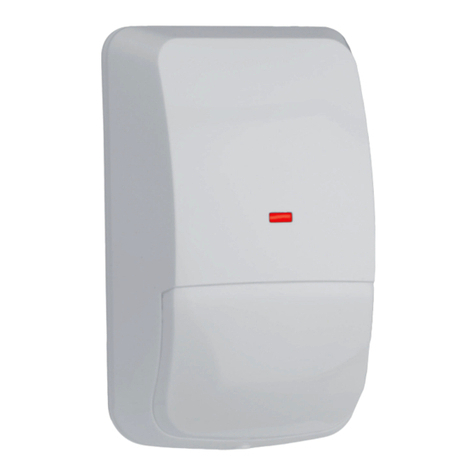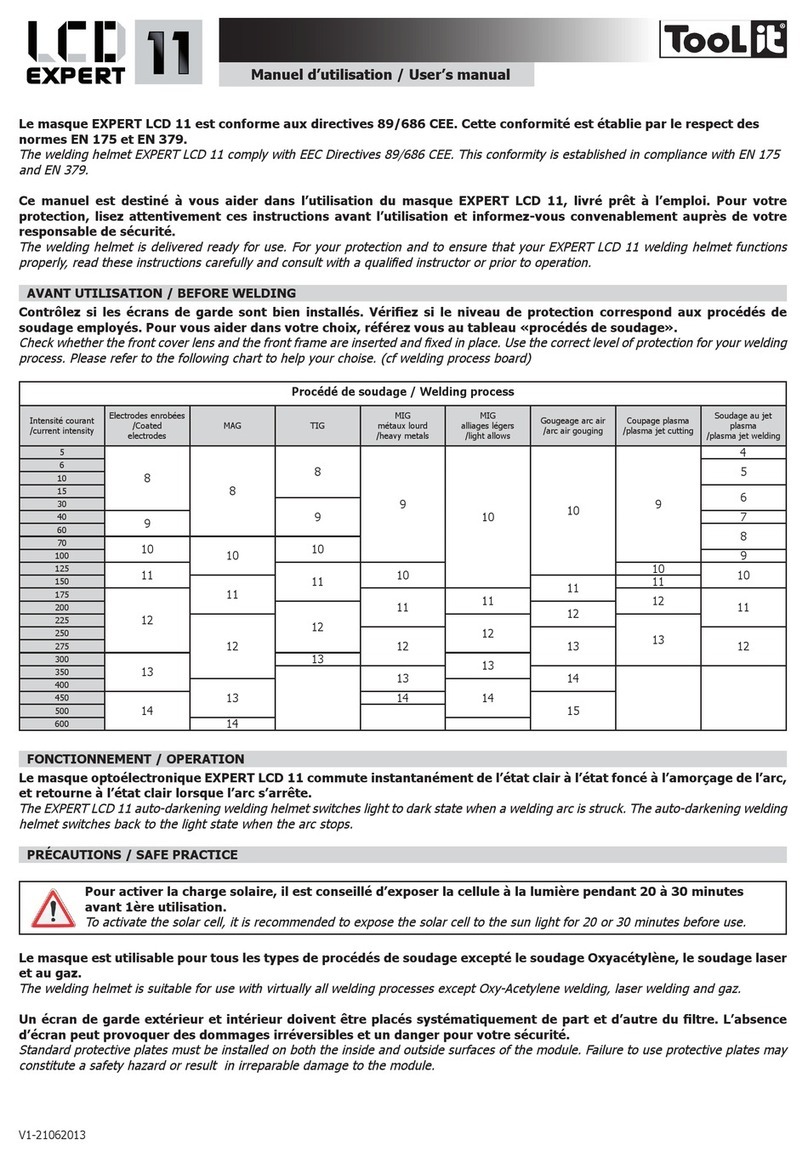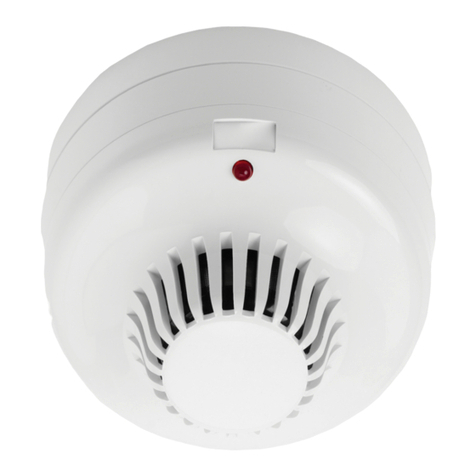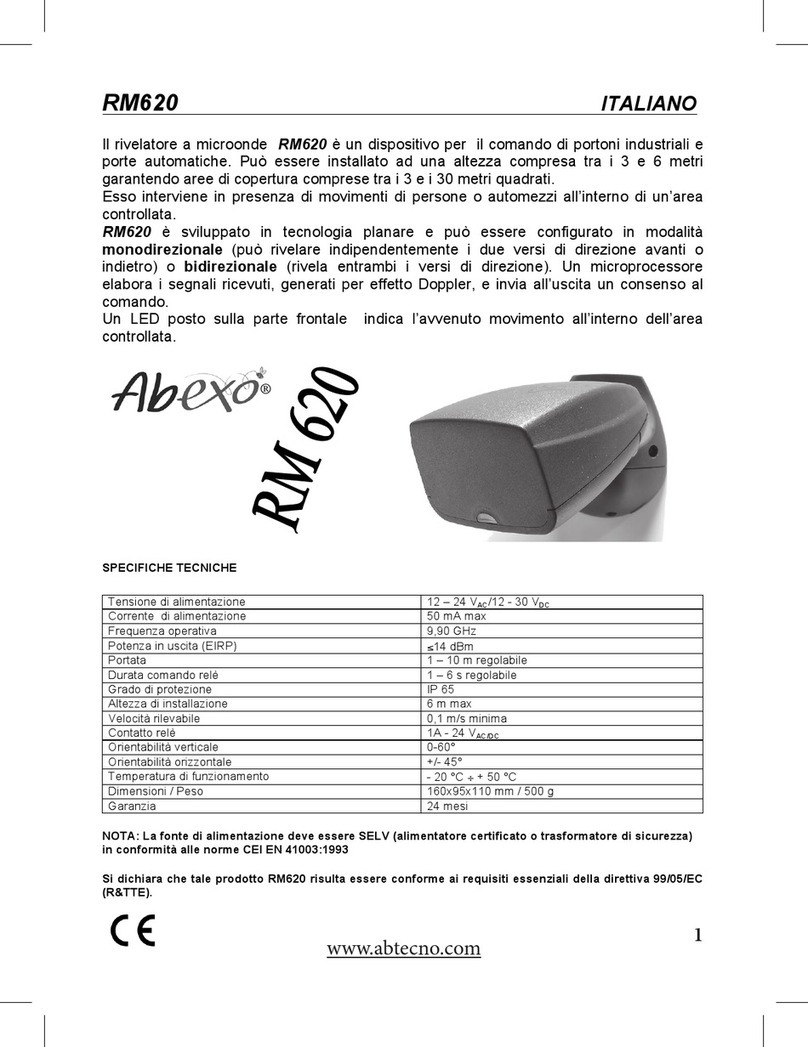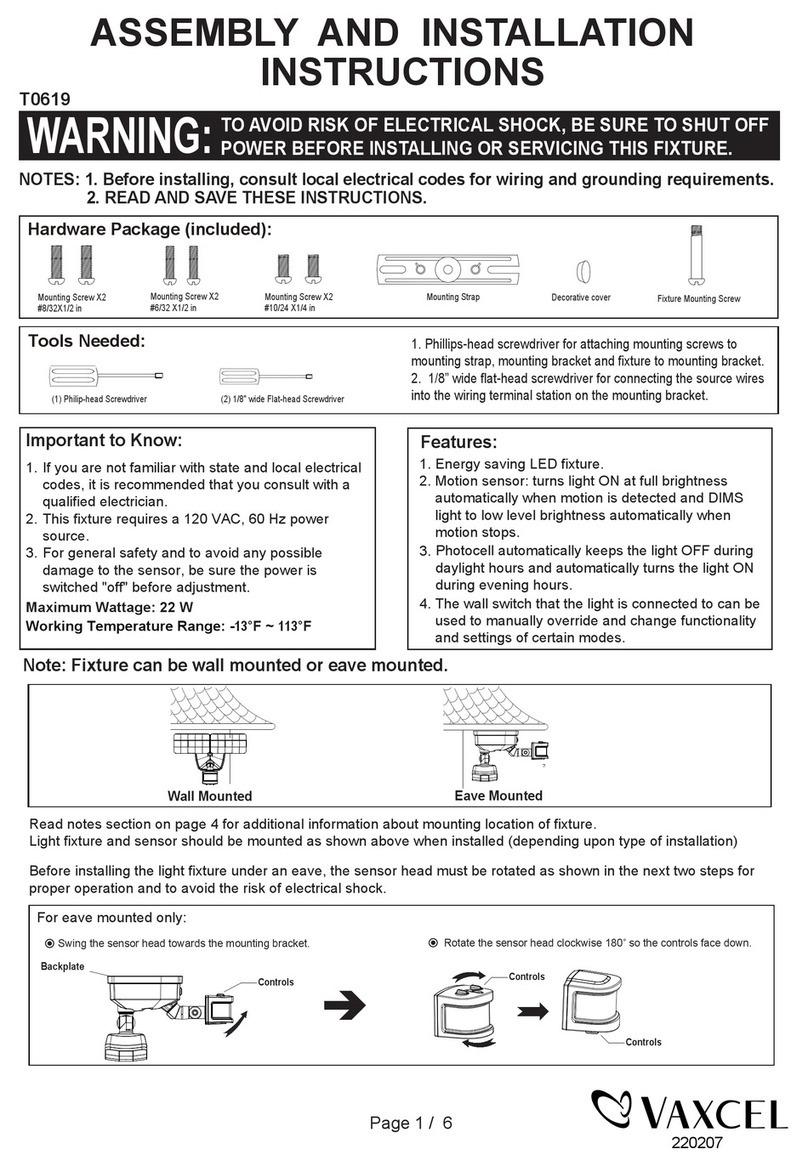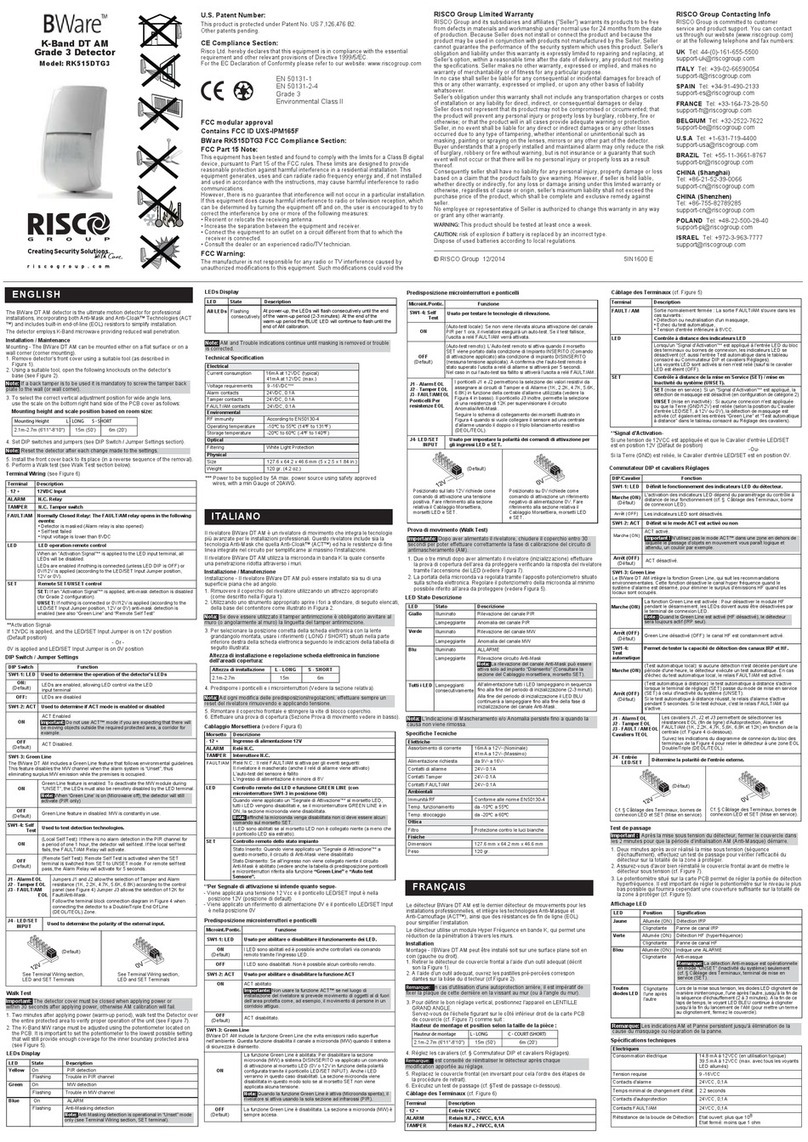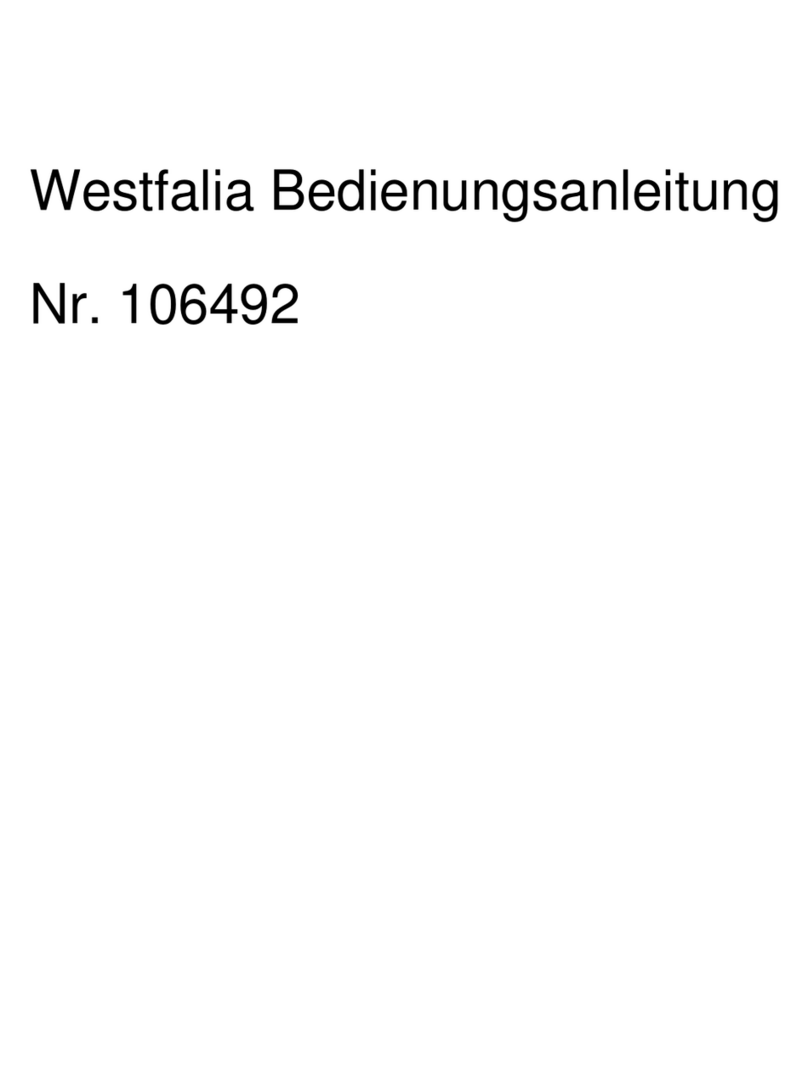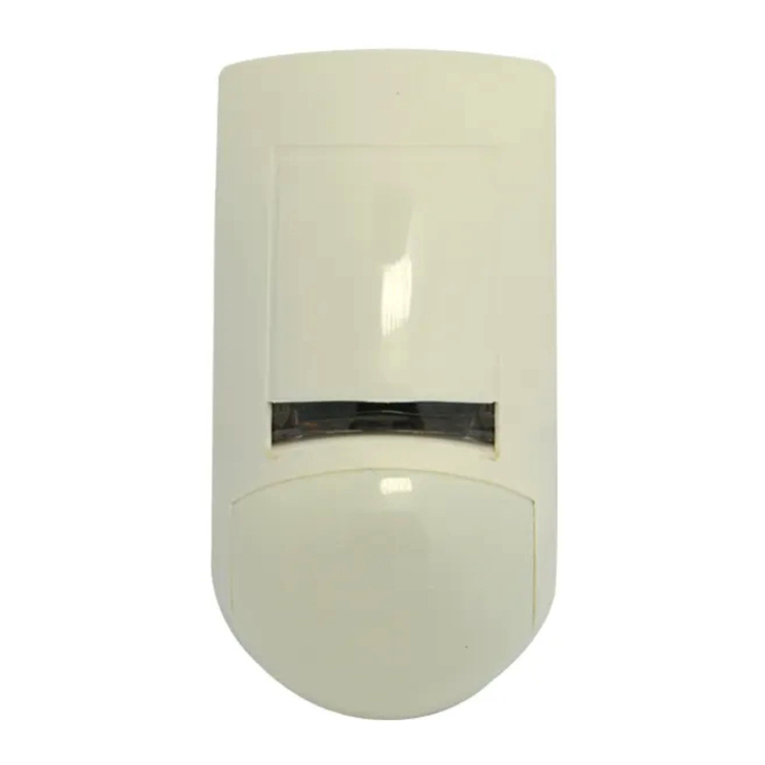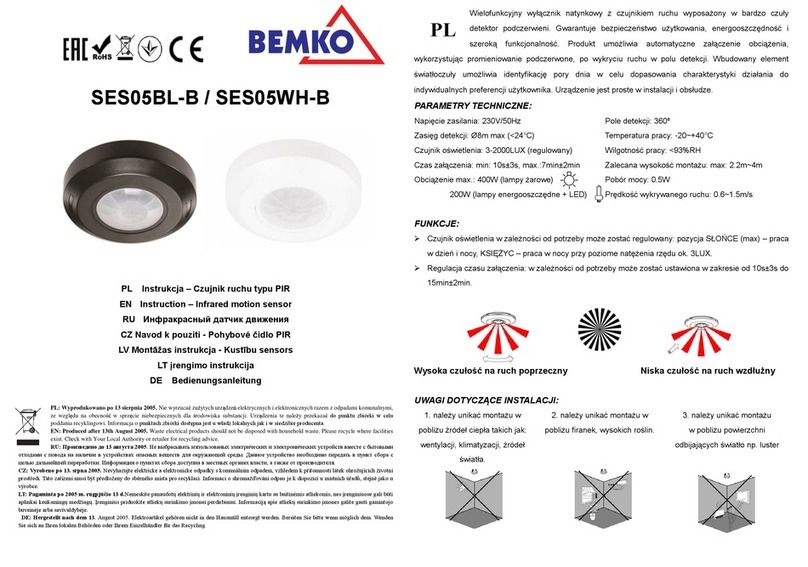EDI 222 Series User manual

THE MODEL 222 SERIES INDUCTIVE LOOP DETECTOR SENSOR UNIT IS DESIGNED AND
MANUFACTURED IN THE USA BY EBERLE DESIGN INC., PHOENIX, ARIZONA,
AN ISO 9001:2008 REGISTERED COMPANY.
U.S. PATENT NO. 7,855,893.
© COPYRIGHT 2015 EDI
SERIAL NUMBER: 1506XXXXX and up
PCB Issue B, 010-6222-001
REVISION: JUNE 2015
pn 888-0222-002
STATE OF CALIFORNIA
MODEL 222
INDUCTIVE LOOP DETECTOR
SENSOR UNIT

Table of Contents
1.1 Glossary .......................................................................................................................... 1
1.2 General Description ......................................................................................................... 1
1.3 General Characteristics ................................................................................................... 2
1.4 Installation and Adjustments............................................................................................ 2
1.5 Loop Installation............................................................................................................... 3
1.6 Theory of Operation......................................................................................................... 4
1.6.1 System Description................................................................................................... 4
1.6.2 Description of Circuit Operation................................................................................ 5
1.7 Maintenance .................................................................................................................... 6
1.7.1 Trouble Analysis....................................................................................................... 6
1.7.2 Trouble Shooting Sequence Chart. .......................................................................... 7
1.8 Specifications................................................................................................................... 8
1.8.1 Mechanical ............................................................................................................. 10
1.8.2 Environmental ........................................................................................................ 10
1.8.3 Electrical................................................................................................................. 10
1.9 Parts List and Schematic ............................................................................................... 11

Model 222
Operations Manual
Eberle Design Inc. Page 1
1.1 GLOSSARY
A - Ampere
oC - Celsius
Component - Any electrical or electronic device
Crosstalk – a symptom of interference between two adjacent loops running at similar frequencies
∆L/L – Change of inductance divided by the nominal inductance
DC - Direct Current
DIP – Dual Inline Package
Firmware - A computer program or software stored permanently in PROM
FLASH – An IC Memory with nonvolatile, electrically erasable, programmable features
Hz - Hertz
IC - Integrated Circuit
Inductance - The property of an electric circuit by which an electromotive force is induced in it as the
result of a changing magnetic flux
Jumper - A means of connecting/disconnecting two or more conductive by soldering/desoldering a
conductive wire or by PCB post jumper
LED - Light Emitting Diode
LOGIC - Negative Logic Convention (Ground True) State
mA - milliAmpere
uH - microHenry
ms - millisecond
MCU - Micro Controller Unit
N.C. - Normally closed contact
N.O. - Normally open contact
Q Factor – A numerical rating for the quality of a resonant circuit. A higher number indicates lower
losses.
PCB - Printed Circuit Board
RAM - Random Access Memory
RMS - Root-Mean-Square
ROM - Read Only Memory Device
s – second
Schmitt Circuit – a circuit that provides hysterisis in the threshold
SW – Switch
uF - microfarad
VAC - Voltage Alternating Current
VDC - Voltage Direct Current
1.2 GENERAL DESCRIPTION
The Eberle Design Model 222 is a dual channel inductive loop vehicle detector sensor unit designed
to meet Caltrans specifications TEES 2009 including Errata #2 (December 2014). The sensor unit
occupies one position of a 170 standard input file. The sensor unit card incorporates a double-sided
44 pin edge connector for the connection of power, loops and call signals. Each channel has
individual front panel controls for setting sensitivity, operational mode and frequency, and is equipped
with high intensity front panel LEDs which are used to indicate the detect state. Call outputs are
optically-isolated and solid-state transistors.

Model 222
Operations Manual
Eberle Design Inc. Page 2
1.3 GENERAL CHARACTERISTICS
Each channel of the Model 222 will tune automatically to any loop and lead-in inductance between 20
and 2000 microhenries and will provide satisfactory operation with lead-ins up to 1000 feet in length.
The unit will detect inductance changes as small as 0.01% ∆L/L. Each channel is sequentially
energized and sampled so as to negate the possibility of crosstalk between loops connected to
different channels of the same detector. Short and consistent sample periods result in fast response
times when operated in the lower sensitivity settings.
1.4 INSTALLATION AND ADJUSTMENTS
Setting up the Model 222 sensor unit:
a. Make sure that the unit is pushed fully home in its position in the input file.
b. Set the Sensitivity for each channel as required.
Sensitivity is set by moving the three DIP switches marked SENS to the desired position.
Position 7 is the highest sensitivity, 0 is the lowest.
Sensitivity ∆L / L SENS 4 SENS 2 SENS 1
Level 7 0.01% ON ON ON
Level 6 0.02% ON ON ON
Level 5 0.04% ON OFF ON
Level 4 0.08% ON OFF OFF
Level 3 0.16% OFF ON ON
Level 2 0.32% OFF ON OFF
Level 1 0.64% OFF OFF ON
Level 0 1.28% OFF OFF OFF
c. Set the Operational Mode for each channel as required.
Operational mode can be set to presence or pulse mode. If presence mode is selected then
short or long presence may be set. Use short presence unless the loop is expected to be
continuously occupied for periods of time in excess of 30 minutes.
Mode MODE 1 MODE 2 Max
Duration
Pulse PL -- --
Short
Presence
PR SH 30 minutes
Long
Presence
PR LG 120 minutes
When the jumper labeled SEL3 is inserted, the Model 222 will limit the minimum presence
time to 100 milliseconds.
d. Set the Frequency for each channel as required.
Frequency setting needs to be changed only if interference occurs between adjacent loops
connected to different sensor units. Interference or crosstalk may manifest itself as
chattering of the call output or a detect call occurring at the same time as an adjacent unit
when there is no vehicle present. If crosstalk is suspected, try to separate the frequencies
of the channels causing the problem. For example, set one to LOW (3) and the other to

Model 222
Operations Manual
Eberle Design Inc. Page 3
HIGH (0). Four frequency positions are available on each channel to assist in alleviating
interference affecting more than two units.
Frequency FREQ 1 FREQ 0
High OFF OFF
Med. High OFF ON
Med. Low ON OFF
Low ON ON
e. If a channel is not to be used, it may be switched off (disabled) by setting the top DIP
switch (switch 8) away from the ON setting.
f. Check the front indicators. If both the DET and FLT indicators on a channel are flashing
and no vehicles are present, there is a problem with the loop or the connections to the loop
on that channel. Check the loop connections carefully.
Note: Each channel may be reset by momentarily selecting channel OFF and then ON
once more.
g. Monitor operation and make adjustments to sensitivity and frequency as necessary.
1.5 LOOP INSTALLATION
The following are suggested guidelines for loop installation:
To begin, make sure that the pavement surface in the area in which the loops are to be installed is
dry and free of debris. The outline of the loops should be marked on the pavement in such a way that
the lines can be followed easily by the saw operator and not be erased by the water feed from the
saw itself.
All 90 degree corners should be chamfered so that the course of the loop wire does not change
direction sharply but rather at shallower angles of 45 degrees or less. Core drilling of the corners
achieves the same effect but can still lead to failure due to sharp edges remaining in the corner area.
When the outline of the loop and lead-in has been marked, the pavement can be cut. Diamond blade
cutting saws are recommended. The saw cut should be approximately 1.5 inches deep and 3/8” to ½”
wide. The saw slot should then be cleaned and allowed to dry. Compressed air is useful both for
ejecting debris and speeding up the drying process. All debris in the vicinity of the saw slot should
also be removed so that it is not accidentally pushed back in.
Recommended loop wire is 14 gauge stranded copper wire with an insulating sheath of polypropylene
type XLPE. IMSA specification 51-1 or 51-3 cable is suggested. Start laying the cable from the
termination of the lead-in out towards the loop, continue around the loop for the number of turns
required and finally return to the lead-in termination. When winding quadrupole loops ensure that the
correct figure-of-eight configuration is maintained with the wires laid in the same direction in the
center arm of the loop. Leave the lead-in cable out of the slot so that it may be twisted together before
being laid in the slot.
As a general rule loops with circumference lengths less than 30 feet require 3 turns of wire, loops with
greater circumference should have 2 turns. Lead-ins should be twisted with a minimum of 4 to 6
twists per foot to prevent any separation of the lead-in wires.
If long lead-ins are required, it is suggested that the loop cable be spliced onto shielded, pre-twisted,
lead-in wire (IMSA spec 50-2 is suggested) at a convenient pull box location close to the loop. The

Model 222
Operations Manual
Eberle Design Inc. Page 4
shield may be connected to earth at the cabinet end but should then be insulated and isolated from
earth ground at the loop end.
Make sure that the loop wire is pushed fully to the bottom of the saw slot. Small pieces of foam rubber
or similar material may be used at various points around the circumference to prevent the loop wire
from rising up while the sealant is poured.
Many different typed of loop sealant are now available. Single part types are the easiest to apply
since no mixing is required, but they also tend to be more expensive in terms of linear feet of saw slot
filled. When applying the sealant, make sure that it is able to sink to the bottom of the slot and
completely encase the loop wire. The wire should not be able to move when the sealant has set.
Ensure that there is enough sealant to completely fill the slot; if possible the sealant should protrude
slightly above the surface of the pavement so that small rocks or other debris cannot collect in the
slot. The sealant manufacturer’s instructions concerning setting time should be noted—especially
when determining the length of time to wait before allowing vehicles to cross the loop area.
1.6 THEORY OF OPERATION
1.6.1 SYSTEM DESCRIPTION
The Model 222 works on the principle of measuring the period of a pre-determined number of cycles
from an oscillator whose frequency is directly related to the inductance of the loop. The measurement
is done by counting the number of cycles of a stable crystal oscillator reference that occur during the
period to be measured. This scheme provides a high resolution measurement in a short period of
time. Consecutive measurements are compared with a reference that has been established to
determine whether or not the frequency of the loop oscillator has changed sufficiently to indicate the
presence of a vehicle. Each channel is sequentially scanned so that only one loop oscillator is
energized at any time.
The sensor circuitry can be broken down into four major blocks. The loop oscillators, digital
processing circuitry, switch controls and the outputs/indicators. Each oscillator input incorporates a
transformer to isolate the loop from the internal oscillator circuitry. Surge arrestors are provided to
protect the unit from transient electrical damage. The Loop oscillator frequency may be modified to
avoid crosstalk problems by switching capacitors into or out of the oscillator circuit. The output signals
from the oscillators are fed through squaring circuits before being supplied to the digital processing
circuit. Although the Model 222 has two loop oscillators, a single digital processing section is used to
measure the period of both oscillators in sequence.
The microcontroller determines the requisite number of loop oscillator cycles over which to perform
the measurement. It then provides this number to the digital processing section and a measurement
is initiated. When the sample period has ended, the sample value is collected and processed by the
microcontroller while another sample is initiated.
Loop
Oscillator
Ch 1
Loop
Oscillator
Ch 2
Digital
Processing
Micro-
Controller
Reference
Oscillator
Ch 1
Switches
Ch 2
Switches
Ch 1
LEDs
Ch 2
LEDs

Model 222
Operations Manual
Eberle Design Inc. Page 5
The microcontroller checks the sample to confirm that it is still within acceptable operating limits and
then determines whether the sample has changed sufficiently with respect to the stored reference to
indicate the presence of a vehicle. It then controls the output and indicator appropriately. Small
changes in period which occur over a relatively long time are considered due to the environment and
are tracked out by altering the stored reference. In this fashion, the sensor unit can adjust for
temperature changes and other long term effects such as the expansion and contraction of the
pavement. The microcontroller maintains the time that a channel has been in the presence condition
and will tune out a continuous presence after 30 minutes (Short Presence mode) or 120 minutes
(Long Presence mode).
The microcontroller first determines the status of the front panel switches. The Operational mode
determines whether the detection calls are to be momentary pulse or continuous. The Presence and
the Sensitivity settings determine the length of the sample to ensure that the sensitivity will be
sufficient to detect the desired types of vehicles and that the response time will be correct.
The microcontroller then begins the oscillator period measurement process by energizing the loop
oscillator for the channel to be measured. During period measurement the digital processing circuit
and the microcontroller count the number of cycles of the crystal based reference frequency.
When the sample period ends, the count is compared with a stored reference and detection decisions
are made. Small changes which occur over a relatively long period of time are considered due to the
changing environment, and the stored reference is modified accordingly by the microcontroller. Larger
changes are deemed to be caused by the presence of a vehicle or vehicles and a detection signal is
initiated.
Detection output calls are made via optically isolated transistors. These isolate the traffic controller
input from the sensor unit circuitry. Output calls are indicated on the front panel by means of high
intensity LEDs labeled “DET”.
1.6.2 DESCRIPTION OF CIRCUIT OPERATION
The following description is valid for both channels of the Model 222. Reference designators are
shown for channel 1 with those relating to channel 2 in parentheses.
Each loop oscillator is based upon two transistors, Q8 (Q9) and Q11 (Q13), loop transformer T1 (T2)
and primary capacitor C11 (C12). The oscillator is enabled by transistor Q7-A (Q7-B). Frequency
modification capacitors C17 and C15 (C18 & C16) are switched in via Q10-B (Q12-B) and Q10-A
(Q12-A). Transient protection is provided by surge arrestor CR5 (CR6). When loops are connected to
the loop input terminals and the unit is under power, the oscillators will attain their natural frequency
according to the inductance of the loop and the capacitance which has been added via the frequency
modification capacitors.
The oscillator output signal is found on the collector of Q8 (Q9) and is sine wave at the oscillator
frequency (while the oscillator is energized). Zener diodes CR13 (CR14) are used to limit any voltage
surges which may appear on the circuit side of the loop transformer.
The loop frequency signals from both of the oscillators are fed into Schmitt circuits U5A (U5B) to form
square wave signals. The outputs of the Schmitt triggers are fed into the digital processing circuitry
integrated into the microcontroller.
The digital processing circuit determines the period of a predetermined number of loop oscillator
cycles and stores this value for retrieval by the microcontroller firmware. This value represents the
period of the loop oscillator waveform to a very high precision.

Model 222
Operations Manual
Eberle Design Inc. Page 6
Front panel switch settings are read directly by the microcontroller parallel ports P3 and P4. The Call
Output opto-isolator U1 (U2) is driven directly by the microcontroller port P1_2 (P1_3). The front
panel LED indicators DS1 (DS2) are similarly driven by the microcontroller port P5.
Monolithic regulator VR1 provides a stable 5 volt DC power supply to the digital circuitry and loop
oscillators. The Model 222 will operate properly until the power input at pin J1-B drops below 8 VDC.
1.7 MAINTENANCE
1.7.1 TROUBLE ANALYSIS
The following list should be used to trouble-shoot the Model 222 installation. If the detector unit itself
is suspect, see Section 1.7.2 for a complete internal testing sequence.
a. Neither channel responds to vehicles.
a. Power supply fault.
The Model 222 requires a 24 VDC nominal supply. Each unit draws between 40mA and 80mA
depending on detect status. The unit will operate at voltages as low as 8 Vdc, however, supply
voltage below this may result in the unit entering a reset state. In this case, the unit will appear
to be non-functional.
b. Reset line held low.
This fault is likely to affect all units in the rack since the external reset line is typically common
to every rack position. Measure the voltage on the External Reset line (pin J1-C). If it is below
15 volts, remove each unit one by one until the next line returns to the power supply level. The
unit that was removed last should be checked carefully for other faults. See Section 1.7.2.
b. Channel does not detect all vehicles.
a. Sensitivity too low.
Increase sensitivity by one setting and observe detection.
c. Channel is noisy or chatters and outputs false detect calls.
a. Two or more units are interfering with each other (crosstalk).
Check frequency settings on units which are connected to loops closest to the one exhibiting
crosstalk; several may be showing signs of crosstalk themselves. Adjust the frequency
switches on all units and all channels affected so that the largest possible margin exists
between frequencies of loops positioned the closest.
b. Poor connections
Loop connections are very important to the satisfactory operation of the sensor unit. All
connections whether they are in the cabinet or at the roadside must be secure, must be
soldered and, in the case of connections made at the roadside, waterproofed to prevent
shorting to ground.
c. Poor loops
Loops which have become degraded due to the passage of traffic may cause the unit to exhibit
crosstalk like symptoms. It may be possible to reduce the sensitivity while maintaining
adequate detection of vehicles. However, the ideal solution is to replace the loop.

Model 222
Operations Manual
Eberle Design Inc. Page 7
1.7.2 TROUBLE SHOOTING SEQUENCE CHART.
Apply 24 VDC power to the unit (pin J1-B) referenced to Logic Ground (pin J1-A). Connect 100
microhenry inductors to the loop inputs pins J1-D (J1-J) and J1-E (J1-K) to simulate the connection of
loops. The following signal measurements are referenced to Logic Ground (pin J1-A):
a. Unregulated Power Supply.
Voltage at test point V_UNREG should be 24 1 Vdc.
Possible component faults are: diode CR11, resistor R13, capacitors C6-C7, or voltage
regulator VR1.
b. Regulated Power Supply.
Voltage at test point VDD should be 5 0.2 Vdc.
Possible component faults are: voltage regulator VR1.
c. Microcontroller Clock.
Waveform at pin 6 of U4 should be a square wave at 22.118 MHz.
Possible components at fault are: Crystal XTL1, U4.
d. Reset Input to Microcontroller.
Voltage at pin 35 of U3 should be less than 0.5 Vdc.
Possible components at fault are: U5-D, U4-C, microcontroller U3.
e. Loop Oscillator Output.
Connect one channel of a dual channel oscilloscope to test point ENABLE1 (ENABLE2).
Select trigger on the rising edge of this signal. Using the other channel of the oscilloscope,
monitor test point LP1 (LP2). The signal should be as follows:
Repeat the above for the second loop detector channel. If the above waveform is not found on
one or both channels of the detector, possible fault areas are Q8 (Q9), Q11 (Q13), Q7-A (Q7-
B), CR13 (CR14), or T1 (T2).
f. Outputs and Indicators.
Monitor the outputs so that when the channel is in the detect state, the outputs can be seen to
be conducting. Enter a detect condition by bringing an aluminum or similar non-ferromagnetic
object close to each simulated loop. The DET indicator should illuminate and the opto-isolated
output U1 (U2) should be conducting.
Possible components at fault are: opto-isolator U1 (U2), CR2 (CR7), or LED DS1 (DS2).

Model 222
Operations Manual
Eberle Design Inc. Page 8
1.8 SPECIFICATIONS
Power Supply:
24 VDC, 80mA maximum, 40mA quiescent.
Loop Input:
The loop inputs incorporate transient protection devices and the loop oscillator circuitry is
transformer isolated. The transient protection will withstand the discharge of a 10uF capacitor
charged to 2,000V across the loop inputs or between any loop input and earth ground. The
transformer isolation allows operation with loops which may be grounded at a single point.
Tuning:
Each channel of the Model 222 will automatically tune to any loop and lead-in combination
within the 20 to 2000 microhenry tuning range (Q factor greater than 5) upon application of
power or when a valid reset signal is received. A channel may be retuned by adjusting mode,
sensitivity or frequency.
Lead-in Length:
The unit will operate with lead-in (feeder) lengths over 1,000 feet with appropriate loops and
proper lead-in cable.
Environmental Tracking:
The Model 222 automatically and continuously compensates drift and environmental effects
throughout the tuning range and across the entire temperature range.
Grounded Loop Operation:
The Model 222 will operate when connected to poor quality loops including those that have a
short to ground at a single point.
Sequential Scanning:
Only one channel is energized at any given time, thus reducing the possibility of crosstalk
between adjacent loops connected to the same unit.
Fault Monitoring :
The Model 222 Loop Monitor continuously checks the integrity of the loop. The system is able
to detect shorted or open circuit loops, or sudden changes in inductance exceeding 25% of the
nominal value. If a fault is detected on a channel, the DET and FLT indicators will flash. The
channel output will remain in the detect (call) state.
i. One flash indicates an open circuit or a loop inductance exceeding the upper limit of the
tuning range.
ii. Two flashes indicate a short circuit or a loop inductance exceeding the lower limit of the
tuning range.
iii. Three flashes indicate that a sudden change in inductance exceeding 25% ∆L/L has
occurred.
If the fault condition is removed, the DET indicator and the channel output will return to normal
operation. The FLT indicator will continue to flash indicating that a fault had previously
occurred.
High Intensity LED Indicators:

Model 222
Operations Manual
Eberle Design Inc. Page 9
Each channel is fitted with a high intensity RED detect LED indicator (DET) and a Yellow Fault
LED indicator (FLT).
Front Panel Controls:
Front panel mounted DIP switches allow the user to set up sensitivity, operational mode,
frequency and channel OFF/ ON state independently for each channel.
Sensitivity:
One of eight settings may be selected to optimize
detection on varying loop and lead-in configurations.
Sensitivity is stated in terms of ∆L/L, i.e. the minimum
percentage change in the total inductance (loop plus
lead-in) to which the unit will respond at the given
level setting.
Channel ON/OFF:
Selecting Channel OFF will disable the channel. In this condition, the loop oscillator is de-
energized, and the output will remain in the no-call state.
Operational Modes:
Pulse Mode (PL): 125 25 milliseconds momentary output
Short Presence (SH): 30 minutes maximum
Long Presence (LG): 120 minutes maximum
When the jumper labeled SEL3 is inserted, the Model 222 will limit the minimum presence time
to 100 milliseconds.
When operating in pulse mode, a vehicle remaining over a loop will inhibit further pulse outputs
from being issued for a period of 2 seconds after which time vehicles passing over the
uncovered portion of the loop will be detected.
Frequency:
One of four settings may be selected to alleviate interference which may occur when loops
connected to different detectors are located adjacent to one another.
Reset Input:
The Model 222 may be reset by applying a ground true logic level to the Reset input pin J1-C.
Response Times:
The following are typical response times at different sensitivity levels. Note: the times indicated
are valid when both channels are set to the same sensitivity operating at approximately
40KHz.
SENS Response
Time
SENS Response
Time
Level 7 40 15 ms Level 3 2.8 1 ms
Level 6 19 7 ms Level 2 2.5 1 ms
Level 5 9 3 ms Level 1 2.5 1 ms
Level 4 5 1.5 ms Level 0 2.5 1 ms
SENS ∆L / L SENS ∆L / L
Level 7 0.01% Level 3 0.16%
Level 6 0.02% Level 2 0.32%
Level 5 0.04% Level 1 0.64%
Level 4 0.08% Level 0 1.28%

Model 222
Operations Manual
Eberle Design Inc. Page 10
1.8.1 MECHANICAL
Height ................................................................................................................... 4.50 inches
Width ................................................................................................................... 1.12 inches
Depth (excluding handle).................................................................................... 6.875 inches
1.8.2 ENVIRONMENTAL
Storage Temperature Range ............................................................................ -45 to +85 oC
Operating Temperature Range......................................................................... -34 to +74 oC
Humidity Range (non-condensing) ............................................................. 0 to 95% Relative
1.8.3 ELECTRICAL
DC Supply Voltage Minimum.................................................................................... 10.8 Vdc
DC Supply Voltage Maximum................................................................................... 28.8 Vdc
DC Supply Current ...................................................................................... 80 mA Maximum
Optically Isolated Solid State Outputs
True (low, 50 mA)...................................................................................less than 1.5 Vdc
Maximum Leakage Current (DC Supply = 24Vdc) .....................................................1 uA
Maximum Current (low) ...........................................................................................50 mA
Isolation...............................................................................................exceeds 5000 VAC
Connections:
Edge Connector mates with connector type Cinch 50-44A-30.
PIN FUNCTION
A Logic Ground
B +24 VDC
C Reset
D & 4 Loop Input CH 1
E & 5 Loop Input CH 1
F CH 1 Output Collector
H CH 1 Output Emitter
J & 8 Loop Input CH 2
K &9 Loop Input CH 2
L Chassis Ground
W CH 2 Output Collector
X CH 2 Output Emitter
Note: Pins M & 11, N & 12, P & 13, R & 14, S & 15, T & 16, U & 17, V & 18, Y & 21, Z & 22
have no connection.

Model 222
Operations Manual
Eberle Design Inc. Page 11
1.9 PARTS LIST AND SCHEMATIC
|------------------------------------------------------------------------------------------------------------------|
|Bill Of Materials for LM222 Production Issue B Rev D.sch |
|------------------------------------------------------------------------------------------------------------------|
|Item|EDI Part Number|Qty|Description |Reference |Manufacturer |
|----+---------------+---+-------------------------------------------------+-------------------+-------------------|
|1 | |1 |(NO COMPONENT) |J1 | |
|2 | |10 |(NO COMPONENT) |ENABLE1-2 GND | |
|3 | |2 | |M1-2 | |
|4 |255-0000-S |5 |RESISTOR, 1/8W, 0 OHMS, 5%, 1206 surface mount |E1 R2 R4 R9 R12 | |
|5 |255-1020-S |3 |RESISTOR, 1/8W, 1K, 5%, 1206 surface mount |R8 R14 R29 | |
|6 |255-1040-S |4 |RESISTOR, 1/8W, 100K, 5%, 1206 surface mount |R10 R37 R41 R46 | |
|7 |255-1060-S |1 |RESISTOR, 1/8W, 10M, 5%, 1206 surface mount |R33 | |
|8 |255-2730-S |2 |RESISTOR, 1/8W, 27K, 5%, 1206 surface mount |R17-18 | |
|9 |255-4720-S |15 |RESISTOR, 1/8W, 4.7K, 5%, 1206 surface mount |R1 R5 R15-16 R20 | |
| | | | |R23 R25 R28 R34 R36| |
| | | | |R39-40 R42-43 R47 | |
|10 |255-5610-S |3 |RESISTOR, 1/8W, 560, 5%, 1206 surface mount |R21 R26 R31 | |
|11 |255-5640-S |3 |RESISTOR, 1/8W, 560K, 5%, 1206 surface mount |R35 R38 R45 | |
|12 |255-6210-S |4 |RESISTOR, 1/8W, 620 Ohm, 5%, 1206 surface mount |R48-51 | |
|13 |255-6800-S |2 |RESISTOR, 1/8W, 68, 5%, 1206 surface mount |R22 R27 | |
|14 |255-6820-S |3 |RESISTOR, 1/8W, 6.8K, 5%, 1206 surface mount |R19 R24 R32 | |
|15 |261-1200-S |1 |RESISTOR, PULSE RATED, 3/4W, 12 OHMS, 5%, 2010 |R13 |SEI |
| | | |smt | | |
|16 |300-2270-016S |2 |CAPACITOR, ELECT,220uF,16WV, 20 %, LOW ESR,6.3mm |C10 C20 |ILLINOIS 227AXZ016M|
| | | |SM | | |
|17 |300-3370-035S |2 |CAPACITOR, ELECTROLYTIC, 330uF, 35V, LOW ESR, |C6-7 |ILLINOIS |
| | | |20%, SMT | | |
|18 |320-1040-050S |11 |CAPACITOR, CER.MULT, 0.1uF, 50V, 10%, 1206 CHIP |C1-3 C13-14 C19 |NXP |
| | | | |C21-22 C24 C27-28 | |
|19 |320-2200-050S |2 |CAPACITOR, CER.MULT, 22pF, 50V, 10%, 1206 CHIP |C25-26 |SAMSUNG |
|20 |320-3910-050S |1 |CAPACITOR, CER.MULT, 390pF, 50V, 10%, 1206 CHIP |C23 |KEMET |
|21 |321-1020-050S |2 |CAPACITOR, CER.MULT, FLEX, 0.001uF, 50V, 10%, |C8-9 |AVX 12065C102KAZ2A|
| | | |1206 CHIP | | |
|22 |330-1040-016S |2 |CAPACITOR, 0.1uF, 5%, POLYPHENYLENE SULFIDE FILM,|C11-12 |NISSEI |
| | | |16VDC, 1210 | |CHA104J16R1210 |
|23 |330-2230-016S |2 |CAPACITOR, 0.022uF, 5%, POLYPHENYLENE SULFIDE |C15-16 |NISSEI |
| | | |FILM, 16VDC, 1206 | |CHA223J16R1206 |
|24 |330-4730-016S |2 |CAPACITOR, 0.047uF, 5%, POLYPHENYLENE SULFIDE |C17-18 |NISSEI |
| | | |FILM, 16VDC, 1206 | |CHA473J16R1206 |
|25 |405-3302-S |1 |IC, LM3302N, QUAD COMPARATOR, SO14 |U5 |NATIONAL |
|26 |410-0050-S |2 |DIODE, TRANSORB,SMBJ5.0CA,SMT |CR13-14 |GENERAL SEMI |
|27 |410-4005-S |2 |DIODE, S1K, 800 PIV, 1A |CR10-11 |TIATRON |
|28 |410-4755-S |2 |DIODE, ZENER, CMZ5941B, 1.0W, 5%, 43V,SMA |CR2 CR7 |TIATRON |
|29 |420-2811-S |2 |OPTOCOUPLER, PS2801-1, 4 PIN SOP |U1-2 |NEC PS2801-1 |
|30 |425-0318 |2 |DISPLAY, LED MODULE, DUAL, RA, HIGH BRIGHTNESS |DS1-2 |SUNLED |
|31 |430-0006-S |2 |TRANSISTOR, MMBTA06LT1, NPN, 80V, 500 mA,SOT-23 |Q3 Q5 |ON SEMI |
|32 |430-3904-S |2 |TRANSISTOR, MMBT3904LT1, NPN, SOT-23 |Q11 Q13 |ON SEMI |
|33 |430-3906-S |2 |TRANSISTOR, PNP, MMBT3906LT1, SOT23 |Q8-9 |TAITRON |

Model 222
Operations Manual
Eberle Design Inc. Page 12
|34 |430-7313-S |3 |Transistor, Dual N Channel FET, IRF7313, SO8 |Q7 Q10 Q12 |IR |
|35 |440-1002-S |2 |GAS DISCHARGE TUBE |CR5-6 |LITTLEFUSE |
| | | | | |SL1002A090SM |
|36 |440-7805-S |1 |MC7805BD2T, 5V REG., 1A, D2PAK |VR1 |MOTOROLA |
|37 |485-7643-S |1 |MICROCONTROLLER, CY8C27643-24PVI |U3 |CYPRESS |
|38 |490-1000-S |1 |IC, 74VHC00, QUAD 2-INPUT NAND GATE, SO14 |U4 |FAIRCHILD |
|39 |520-0102-P |1 |Connector, Header, 2 Pin |SEL3 |SAMTEC |
|40 |520-0105-P |1 |CONCECTOR, HEADER, 5-PIN, ISSP PORT |J2 |SAMTEC |
|41 |630-1080 |2 |SWITCH, DIP-SWITCH, 8 POS, RT. ANGLE |SW3-4 |C&K |
|42 |651-2212-S |1 |CRYSTAL, 22.118 MHZ, 20pF, AT CUT, HC49, SMT |XTL1 |ECS ATS-SM SERIES |
|43 |780-0060 |1 |POLYCARBONATE COVER |CVR2 |AZP |
|44 |800-0116-S |2 |TRANSFORMER,LOOP, RM6, SMT |T1-2 |TRANSTEK MAGNETICS |
|------------------------------------------------------------------------------------------------------------------|

Model 222
Operations Manual
Eberle Design Inc. Page 13

Model 222
Operations Manual
Eberle Design Inc. Page 14

Model 222
Operations Manual
Eberle Design Inc. Page 15
Table of contents
Other EDI Security Sensor manuals
